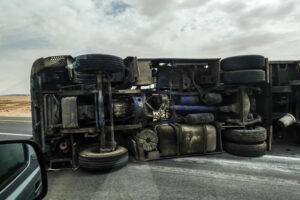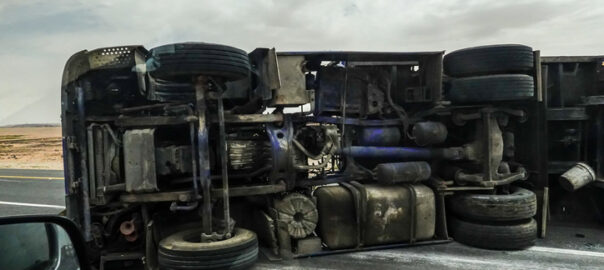Rollover accidents are a massive issue for the trucking industry. Each year, an estimated 500,000 accidents involving trucks occur in the U.S. Big rigs roll easily. You can roll your truck while moving as slow as five mph, especially when descending at grade, around a curve, cornering, or reversing while jackknifed.

Rollover truck accidents are responsible for an estimated 20,000 injuries and fatalities annually. So, what can you, as a driver, do to reduce these numbers and be proactive about rollover prevention?
Hard to Handle Shifting Loads
Shifting loads is one of the most easily corrected issues in rollover prevention. Do not drive a load that can shift. Check all straps, chains, and tie-downs before taking the load and again at every stop. Preventing the load from shifting before it becomes a problem is the key.
Small Pavement Drops
A significant amount of rollover accidents are caused when a truck drops one or more tires off the pavement. Remember, anytime you drop a tire off onto the shoulder, you should not attempt to return to the lane immediately. Slow your truck and bring it to a stop. Get out and assess the area, looking for opportunities to return to the roadway or hazards against it. If hazards are present, call a wrecker.
If no hazards are present and you choose to attempt re-entry, stay at a safe speed until all the tires are back on the pavement. Also, keep your angle of re-entry as shallow/narrow as possible. It may look like a small drop off the pavement, but it is a big cause for caution.
Tanker Loads – A Glass Half-Empty
Tankers that are less than 3/4 full are dangerous because of the load shift, or “slosh factor.” This shift can throw the truck off balance and cause a rollover. Tankers with baffles, which aid in rollover prevention, can help reduce the amount of “sloshing.”
Remember that loads shifting forward or backward can cause the trailer brakes to lock up and skid, especially for tankers. Tankers with “sloshing’ risks should be assessed and addressed before your trip begins. Since these types of loads are not secure enough to prevent truck rollovers, these loads should be treated with caution.
Divided Attention
Most rollover accidents are reportedly caused by operator error. We know this is not necessarily the case. Many factors can cause a rollover accident outside the operator’s control or blame:
- Weather
- Pavement
- Traffic
- Road Hazards
- Shifting Loads
- Tire Pressure
The main catalyst that can be the deciding factor between your load arriving safely and your becoming a statistic is your focused attention. Complacency is a killer, especially for truck drivers who travel the same routes routinely.
Knowing what lies around the next corner and assuming the road conditions will be the same as yesterday is a mistake. Avoid concentration detractors such as cell phones, radios, pets, food, and any other distractions inside the cab.
In Case of Emergency
In case of a rollover, especially involving hazardous materials, notify emergency services immediately. Include any information you can about the location and type of wreck, as well as a description of the load if pertinent to public safety. If you can exit the cab without risking additional personal injury, assess the wreck site for secondary crash hazards.
Always be aware of traffic patterns, and do NOT stand in the roadway while awaiting help, especially after dark. If you are not injured, attempt to keep Samaritans away from fluids leaking from the truck. Be aware that even though the rig may not have caught fire immediately, it is possible that hot fuel and damaged batteries can ignite at any time.
Truck rollovers cannot always be prevented, but they can be minimized with a bit of proactive thinking prior to hitting the road. When you partner up with a company like Landstar Trucking, you have the peace of mind that Landstar always has your safety first in mind!


